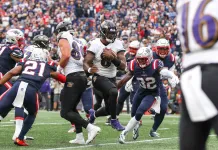Super Bowl Sunday is the sports betting world’s biggest day, regardless of which teams are competing for the Lombardi Trophy. While the Super Bowl is only one game, the number of betting options available is beyond comprehension, ranging from the simple point spread to exotic props. You can even bet other sports events that day against the stats or results of the football game. If you’ve never taken the time to digest all the betting opportunities available on game day, be sure to do so. At the very least, you will be amazed by the creativity of the oddsmaking minds.
This year’s Super Bowl will be the 55th in history. With a sample size of 54 previous games, you’ll want to consider those results as you contemplate how this year’s game might play out, checking for similarities between this year’s matchup and past games. How can you know where you’re going if you don’t understand where you’ve been?
I’ll share some trends and patterns that have emerged from the Super Bowl over the years. Perhaps these will strongly influence your final decisions, perhaps not. Either way, you’ll be more knowledgeable about the game’s betting history than the friends you’re gathering with.
%%offer%%
Hopefully, with everything we’re offering in this publication and over the next two weeks on our VSiN network and in Point Spread Weekly, you will go in knowing you’ve prepped accordingly. Part of that preparation should involve looking at the history of the game. So let’s look back at 54 years of Super Bowl action, uncovering the stats, trends and systems you’ll need to make educated selections.
Super Bowl Game Stat Angles
Over the two-week break between the conference championships and the Super Bowl, both teams will get to know the other’s tendencies inside and out. Their excellent coaching staffs will pore over game film and prepare such thorough game plans that nothing will surprise them. Teams that get to this point earn it, and since the NFC’s run of dominance ended in the late 1990s, there really hasn’t been a physical mismatch in the Super Bowl besides Seattle’s 2014 win over Denver. That means the game most often comes down to preparation and execution.
This execution is typically measured by statistics. Rushing yards, passing yards per attempt, turnovers and time of possession are four key stat categories I have found to have a great impact on Super Bowl outcomes. The following trends demonstrate the importance of these statistics.
— Teams that rush for more yards in the Super Bowl are 40-14 SU and 37-14-3 ATS (72.5%). But the Chiefs were outrushed last year by the 49ers 141-129.
— Teams that average more passing yards per attempt in the Super Bowl are 42-12 SU and 36-15-3 ATS (70.6%). The Chiefs’ previously dynamic attack produced just 6.38 yards per pass attempt last year, but they still won.
— In the 54 previous Super Bowls, the team that has more turnovers has won just six times SU and eight times ATS (8-35-8, 18.6%). One of the biggest reasons for the Broncos’ win in 2016 was forcing four turnovers by the Panthers. In last year’s game, the Chiefs and 49ers both turned it over twice.
— Teams that win the time-of-possession battle are 39-15 SU and 38-13-3 ATS (74.5%). The Chiefs were the latest to win on that edge, holding the ball for over 33 minutes on the 49ers last year.
— Teams that hold an edge in at least three of these four key statistical categories are 39-5 SU and 35-8-1 ATS (81.4%). Amazingly, three of those outright losses were in the last six games.
— Teams that win all four categories are 25-0 SU and 23-1-1 ATS (96%). The only ATS loss occurred in Super Bowl XXXIX in Philadelphia’s ATS win over New England.
San Francisco won two of the four categories last year and tied in turnovers yet still lost. Turnovers are hard to predict, but the other stats should be relatively predictable for any advanced handicapper or service regularly using sophisticated statistical models for simulation. Projecting these numbers can certainly be worth the effort.
In-Game Scoring Trends
— The average winning score is 30.1 with the average losing score at 16.1, an average winning margin 14 ppg. However, 16 of the last 17 games have been decided by 14 or fewer points, a sign of a much more competitive era in the NFL.
— The 2008 Giants became the first team in 33 years to win the Super Bowl without hitting the 20-point mark. The Patriots did it again in 2019 with the lowest winning point total ever, 13.
— Since Pittsburgh’s epic 35-31 win over Dallas in Super Bowl XIII in 1979, 25 teams have hit the 30-point mark. Their record: 23-2 SU and 22-3 ATS. Only New England, a 32-29 winner over Carolina in ’04, San Francisco in 2013 and New England in ’18 failed to cover their point spreads.
— In 21 previous Super Bowls, teams have failed to reach the 14-point mark. Their record: 1-20 SU and ATS (4.8%). This is another trend illustrating just how improbable the Patriots’ 2019 win was.
— More on the recent competitiveness of the game: Of the 16 games to be decided by less than a touchdown, seven have been in the last 13 years.
Previous Super Bowl Line and Total Patterns
Since the turn of the century, what it takes to reach Super Bowl success has come and gone in waves. In the first few years of the 2000s, it was top seeds or teams that achieved lofty won-lost marks in the regular season fulfilling expectations.
Then something changed. From 2006-13, seven teams that played on wild-card weekend made it to the Super Bowl — and six of them won! The 2006 Super Bowl run by Pittsburgh was significant as I believe it dramatically changed teams’ beliefs as to what it takes to become an NFL champion. The Steelers were the first No. 6 seed to emerge with the Lombardi Trophy. The assumptions that winning in the regular season, earning a bye and capitalizing on home-field advantage were the recipe for postseason success were thrown into doubt.
The last seven Super Bowls may represent a return to normalcy, with all but two teams having won at home in their conference title games after enjoying byes on wild-card weekend. However, the fact that underdogs have won outright in four of those seven games is another wrinkle to deal with.
All of this has naturally made it difficult on handicappers who rely on such things as strength ratings and historical templates that have demonstrated the best teams excelling when it mattered most — in the playoffs.
ATS and Moneyline Trends
— Super Bowl favorites are 34-19 SU and own an ATS mark of 25-25-3 (50%), with the 1982 game having been a pick-’em point spread. However, over the last 18 years, underdogs own a 13-6 ATS (68.4%) edge, including 9-4 ATS in the last 13. Kansas City won as the slimmest of favorites in 2020.
— Favorites of a touchdown or more are 3-2 SU but 0-4-1 ATS (0%) in this millennium. But there hasn’t been a favorite of that magnitude since the Patriots in 2008.
— The straight-up winner is 45-6-3 ATS (88.2%) in the 54 previous Super Bowls, and the dog has never covered a point spread without winning on a Super Bowl line of fewer than six points. This figure is now the highest of the four playoff rounds. Champions typically leave no doubt.
— Remarkably, the AFC and NFC have split 27-27 outright in the first 54 Super Bowls, but the NFC holds a 27-24-3 (52.9%) ATS edge. However, AFC teams have turned the tide recently with a 5-2 SU and ATS surge in the last seven.
— The team that is the higher playoff seed is just 2-14-2 ATS (12.5%) in the last 24 Super Bowls. Equal seeds matched up in 2011, ’14, ’15, ’16, ’18 and ’19.
— The team with the better record going into the Super Bowl is 29-18 SU all time but has lost 10 of the last 11, including the 49ers (13-3) against the Chiefs (12-4) a year ago.
— Teams playing in their first Super Bowl against an experienced club are 6-2-1 ATS in their last nine. But this trend is becoming more and more scarce and won’t apply this year.
Over/Under Trends
— In the 53 Super Bowl games that have had totals, the Over is 27-25-1 (51.9%). The last two have gone Under, the first time for back-to-back Under results since four straight from 2005-08. The 2019 game went Under in record fashion, falling short of the posted number by 39 points.
— On average, 46.3 points have been scored per Super Bowl, with posted totals averaging 44.7. However, the early years’ totals were often in the 30s, dragging down that number significantly. The last 16 years have featured an average posted total of 49.7, with 46.9 scored. Nine of the 16 games in that era went Under.
— In the last 11 Super Bowls with totals in the 50s, the Under is 8-3 (72.7%).
— The 2020 Super Bowl was one of only 17 in which both teams reached the 20-point mark. Fourteen of those went Over. Consider that with the quality of offenses expected in this year’s game.
Six-Point Teaser Trends
— In terms of six-point teaser trends, favorites have gone 35-18 (66%) while underdogs have gone 35-17-1 (67.3%), very close performance marks. The ’82 game was a pick-’em. However, the last 19 seasons have featured a big separation as favorites are just 10-9 (52.6%) while underdogs are 16-3 (84.2%).
— AFC teams are 35-18-1 (66%) and NFC teams are 37-17 (68.5%) in the history of the Super Bowl game on six-point teaser bets.
— Concerning Super Bowl totals, in the 53 games that had posted numbers, Over is 36-17 (67.9%) and Under is 35-17-1 (67.3%) on six-point teasers.
Teams’ Regular-Season Offensive Statistics Trends
— Teams that scored more points per game during the regular season are only 5-13 ATS in the last 18 Super Bowls.
— The ability to run the football has been much overrated for Super Bowl success. Teams that averaged more rushing yards per game are just 4-12 ATS since ’05. Those that averaged more yards per rush are 6-10 ATS in that span.
— Passing yardage has also meant little in terms of Super Bowl success, with teams owning an edge in total offensive passing yardage going only 8-11 ATS in the last 19 games.
— Big-play potential hasn’t been a key ingredient in Super Bowl victories, as teams gaining more passing yards per attempt are on a 6-8 ATS stumble.
— Teams that generated more yardage in the regular season also own no edge when it comes to Super Bowl success, losing nine straight games SU and ATS. Those with yards-per-play edges are 1-8 SU and ATS in that span.
— Offensive yards per point has proven to be an effective statistical indicator for fading teams. Teams that have averaged fewer yards per point are just 5-13 ATS in the last 18 Super Bowls.
— The offensive turnovers statistic has also been quite misleading for Super Bowl handicapping, with teams owning an edge in this stat going just 6-11 ATS in the Super Bowl since ’03.
— Teams that converted third-down opportunities more efficiently in the regular season also have a poor trend mark, going 7-12 ATS in the last 19 Super Bowls.
As you can see, it almost seems detrimental to have generated better offensive statistics in the regular season.
Teams’ Regular-Season Defensive Statistics Trends
— Teams that allowed fewer points per game during the regular season are 6-8 ATS in the last 14 Super Bowls.
— Teams that allowed fewer rushing yards per game and fewer yards per rushing attempt have gone just 7-12 ATS in the last 19 Super Bowls, giving the statistical handicapper little reason to consider it when analyzing the games other than fading.
— Super Bowl teams with an edge in passing yardage allowed over their opponent are 11-7 ATS over the last 18 seasons. Finally an edge for the better statistical team!
— Teams with the edge in defensive pass efficiency are 6-3 ATS over the last nine years but just 6-8 ATS in the last 14 Super Bowls.
— Teams that allowed less yardage overall are just 5-9 ATS since ’07 but 5-4 ATS since ’12 in the Super Bowl. Teams with an edge in yards per play are 6-8 ATS since ’07 but 6-3 ATS in the last nine.
— Defensive yards per point should be given serious consideration for Super Bowl Sunday, but only if you are fading the team with the edge — 6-9 ATS since ’06.
— Teams that forced more turnovers in the regular season are 9-10 ATS since ’02 in Super Bowl play, with no streaks greater than two either way.
— Teams that stopped third-down opportunities more efficiently in the regular season are on a 6-5 ATS run in the last 11 Super Bowl games.
Again, very little evidence indicates that having better regular-season defensive statistics provides any advantage in this single high-stakes game. It seems as if we should ignore statistical handicapping. Fortunately, we came up with other trends that might help, most notably those regarding underdogs, won-lost/seed records and outright winners.
One final thing: If you like to follow the line moves closely, hoping that sharp money may be the cause, consider that bettors are only 7-6 ATS in the last 13 Super Bowls in which they moved an opening line and just 8-6 in the last 14 in which they moved totals. However, the total moves were winners in each of the last three years, so perhaps this is an emerging strategy. The line-move winning percentages were much more significant in the earlier playoff rounds. Be sure to follow that action in the hours leading up to kickoff if you believe in this type of analysis.





